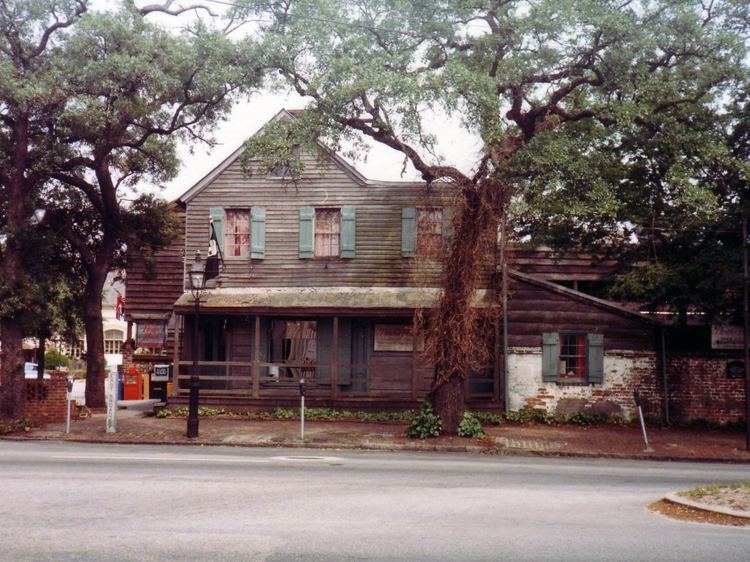 | ||
The Pirates' House is a historic restaurant and tavern established in 1753 located in downtown Savannah, Georgia in the Southern United States. It is thought to be the oldest standing building in the state of Georgia. The restaurant is one of Savannah's most-popular tourist attractions.
Contents
History
The Pirates' House was built on a plot of land located on the east side of James Oglethorpe's original plan of the city of Savannah. The plot of land was assigned to become a botanical garden that modelled the Chelsea Botanical Garden in London, England. The garden was dedicated to Oglethorpe's Trustees. Oglethorpe recruited botanists from around the world to acquire plants for the project such as cotton, spices, indigo, and medicinal herbs. The garden was hoped to bring success in the wine and silk industries, and was centred on growing mulberry trees. The soil and weather conditions of Georgia were not compatible with the mulberry trees and it was not successful with wine or silk. However, it did distribute peach trees which Georgia is currently renowned for. The garden was also highly successful in growing cotton which later became a staple of Georgia's economy.
A small building which later became the starting structure of the Pirates' House was built on the plot of land in 1734 to house the gardener who worked there. This building was deemed the Herb House and is said to be the oldest building in the state of Georgia (see List of the oldest buildings in Georgia).
In 1754, the people of Savannah decided the need for the botanical garden was no longer relevant. Savannah was quickly becoming a port town and The Herb House was transformed into an Inn and tavern for seaman visiting from abroad. The Pirate's House Inn constantly hosted seaman, pirates and the underbelly of the society; in time, it earned a reputation of being a place the general public avoided.
It did not earn this reputation by rumour. Many drunken sailors have gone missing from the Pirates' House. Captains that were in need of men often came to the Pirates' House to find drunken, vulnerable sailors. Many of these sailors travelled here from distant lands on merchant ships. If they went missing in Savannah it would be difficult to find what happened to them. Savannah is home to many underground tunnels and the Pirate's House is the entrance to one of them.
These tunnels are thought to have been built for different times for different purposes. A portion of the tunnels are said to have been built during the yellow fever epidemic that took place in Savannah during the 1800s to hide the bodies of the dead from the general public. The other tunnels were possibly used as hideouts in the underground railroad system. Another section of tunnels found under a hospital in Savannah is thought to have been used as a morgue. In the cellar of the Pirates' House there is a tunnel, now sealed off, that, purportedly, leads to the Savannah River. According to a tour guide (by the name of Chris) with Old Savannah Tours, hard liquor had been prohibited by law in Savannah and the cellar of the Pirate's House was originally used to smuggle barrels of rum into the city. City officials were, supposedly, aware of the presence of the contraband, but were given free access to the libation in exchange for their silence on the matter.
The tunnel is also said to have a more notorious purpose. The captains would wait until an unsuspecting sailor was drunk and flog them over the head. The unconscious sailors would be taken through the tunnel by crew members led by the captain. The sailors would then awake to a life of bondage on the pirate's ship. The people of Savannah soon coined the term shanghaied because the sailors were thought to have been taken off to China, never to be seen or heard from again.
It was also explained, by the same tour guide with Old Savannah Tours, that many tortures and murders occurred in the cellar of the Pirate's House. The story goes that trap doors were installed in the floor of the tavern and that drunk sailors who had passed out were chained and dropped into the cellar below. Should they sustain an injury in a fall and were unable to work on a ship, then they were murdered in the cellar and their bodies later disposed of.
The Pirates' House is home to some rare early edition pages of Treasure Island, by Robert Louis Stevenson. The pages can be seen hanging on the walls of the Captain's room and the Treasure room in the Pirates' House.
The current owners of The Pirates' House claim that Captain Flint, a pirate mentioned in the book Treasure Island by Robert Louis Stevenson, died in the upstairs bedroom at the Pirate's House. However, as Flint is a completely fictional character, this story cannot be historically true, and the additional claim that Flint haunts the place as a ghost suggests that these claims are not intended to be taken seriously. Moreover, although the novel states that Flint died in Savannah, nothing in it states or suggests that The Pirates' House is the location of his deathbed.
Renovation and ownership
In 1948, the Pirates' House and the surrounding land was acquired by The Savannah Gas Company. The building soon caught the interest of Mrs. Hansell Hilyer, wife of the president of The Savannah Gas Company. She renewed the house museum into the restaurant of present day. The Pirates' House has 15 dining rooms, can hold up to 120 guests and serves a variety of southern dishes. Many of its recipes can be found in "The Pirate's House Cook Book" by Frances McGrath.
